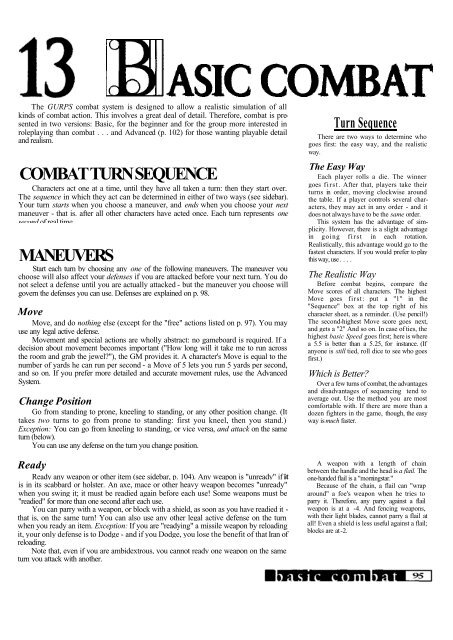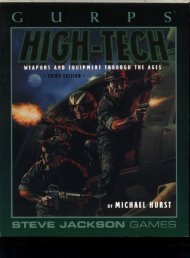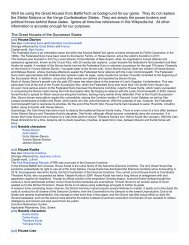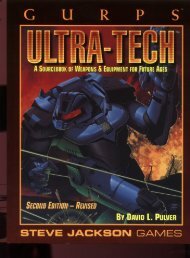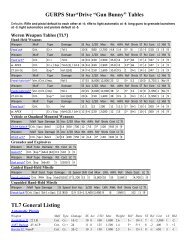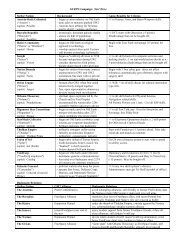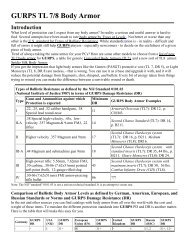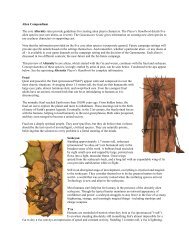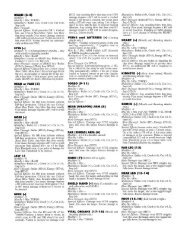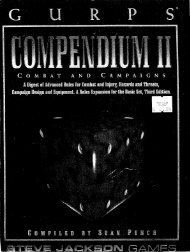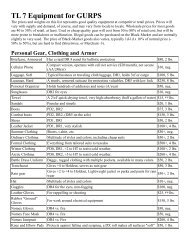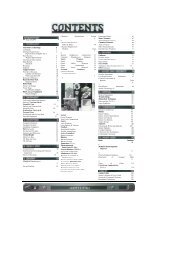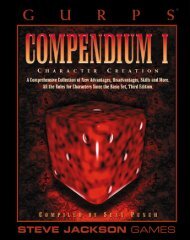The <strong>GURPS</strong> combat system is designed to allow a realistic simulation of allkinds of combat action. This involves a great deal of detail. Therefore, combat is presentedin two versions: <strong>Basic</strong>, for the beginner and for the group more interested inroleplaying than combat . . . and Advanced (p. 102) for those wanting playable detailand realism.COMBAT TURN SEQUENCECharacters act one at a time, until they have all taken a turn: then they start over.The sequence in which they act can be determined in either of two ways (see sidebar).Your turn starts when you choose a maneuver, and ends when you choose your nextmaneuver - that is. after all other characters have acted once. Each turn represents onesecond of real time.MANEUVERSStart each turn by choosing any one of the following maneuvers. The maneuver youchoose will also affect your defenses if you are attacked before your next turn. You donot select a defense until you are actually attacked - but the maneuver you choose willgovern the defenses you can use. Defenses are explained on p. 98.MoveMove, and do nothing else (except for the "free" actions listed on p. 97). You mayuse any legal active defense.Movement and special actions are wholly abstract: no gameboard is required. If adecision about movement becomes important ("How long will it take me to run acrossthe room and grab the jewel?"), the GM provides it. A character's Move is equal to thenumber of yards he can run per second - a Move of 5 lets you run 5 yards per second,and so on. If you prefer more detailed and accurate movement rules, use the AdvancedSystem.Change PositionGo from standing to prone, kneeling to standing, or any other position change. (Ittakes two turns to go from prone to standing: first you kneel, then you stand.)Exception: You can go from kneeling to standing, or vice versa, and attack on the sameturn (below).You can use any defense on the turn you change position.ReadyReady any weapon or other item (see sidebar, p. 104). Any weapon is "unready" if itis in its scabbard or holster. An axe, mace or other heavy weapon becomes "unready"when you swing it; it must be readied again before each use! Some weapons must be"readied" for more than one second after each use.You can parry with a weapon, or block with a shield, as soon as you have readied it -that is, on the same turn! You can also use any other legal active defense on the turnwhen you ready an item. Exception: If you are "readying" a missile weapon by reloadingit, your only defense is to Dodge - and if you Dodge, you lose the benefit of that Iran ofreloading.Note that, even if you are ambidextrous, you cannot ready one weapon on the sameturn you attack with another.Turn SequenceThere are two ways to determine whogoes first: the easy way, and the realisticway.The Easy WayEach player rolls a die. The winnergoes first. After that, players take theirturns in order, moving clockwise aroundthe table. If a player controls several characters,they may act in any order - and itdoes not always have to be the same order.This system has the advantage of simplicity.However, there is a slight advantagein going first in each rotation.Realistically, this advantage would go to thefastest characters. If you would prefer to playthis way, use ....The Realistic WayBefore combat begins, compare theMove scores of all characters. The highestMove goes first: put a "1" in the"Sequence" box at the top right of hischaracter sheet, as a reminder. (Use pencil!)The second-highest Move score goes next,and gets a "2" And so on. In case of ties, thehighest basic Speed goes first; here is wherea 5.5 is better than a 5.25, for instance. (Ifanyone is still tied, roll dice to see who goesfirst.)Which is Better?Over a few turns of combat, the advantagesand disadvantages of sequencing tend toaverage out. Use the method you are mostcomfortable with. If there are more than adozen fighters in the game, though, the easyway is much faster.A weapon with a length of chainbetween the handle and the head is a flail. Theone-handed flail is a "morningstar."Because of the chain, a flail can "wraparound" a foe's weapon when he tries toparry it. Therefore, any parry against a flailweapon is at a -4. And fencing weapons,with their light blades, cannot parry a flail atall! Even a shield is less useful against a flail;blocks are at -2.
Reloading TimeSling: 2 seconds to reload - can befired every 3 seconds.Bow: 2 seconds to reload - can be firedevery 3 seconds.Crossbow (your ST or less): 4 secondsto cock and reload - can be fired every 5seconds. If ST is up to 2 greater thanyours: 8 seconds to cock and reload - canbe fired every 9 seconds.Guns: Repeating guns are divided intothree kinds: replaceable magazine, integralmagazine and revolvers.Integral magazines take 3 seconds ofpreparation, plus one second per round.Changing magazines for a replaceaplemagazine gun (or stripping a clip into aMauser-type action) takes 3 seconds (oneto prepare, one to acquire, one to insert).Revolvers: Single-ejecting revolverstake one second to prepare for unloadingand one second per round to unload theempties. Reloading takes one second toprepare and two seconds per round to load,plus one second to ready for firing or carrying.Simultaneously-ejecting revolverstake three seconds of preparation plus onesecond per round of loading time.See also the Speed-Load skill (p. 52)."My Weapon's Stuck!" -The Problem with PicksWeapons that are swung for impalingdamage - picks and the like - do a greatdeal of damage. The drawback is this: theymay get stuck in your foe!Any time such a weapon penetrates thefoe's armor, it may stick. On your nextturn, roll against your ST. A successful rollmeans your weapon is not stuck, and youmay re-ready it on the following turn.A failed roll means it is stuck. You cannotuse it or ready it. You may roll again at thebeginning of each turn to try to unstick it,but you can do nothing until you succeed.A critical miss on this roll (a 17 or 18)means the weapon is permanently stuck,and you might as well drop it; you canrecover it after combat, if you survive.When the pick comes unstuck, it doeshalf as much damage as it did originally.For example, if the final damage done bythe original wound was 4 or 5 hits, it doesanother 2 hits when it is pulled free.If you cannot pull your pick free duringcombat, your attempts do your foe no extradamage (for game purposes). After combat,you will be able to recover the pick ifyour foe is lying on the battlefield.If your weapon is stuck in a foe, and hetries to move away, roll a Quick Contest ofStrength. If your foe wins, he pulls theweapon out of your hands. If you win,your foe can't move. If you tie, the weaponcomes loose and does damage as above.Weapons with this drawback includepicks, warhammers and (when swung toimpale) halberds.ReloadingUse the "Ready" maneuver to reload a missile weapon. This will require severalturns. With a sling, for instance, you need one second to "ready" the rock, and one secondto put the rock in the sling. If you don't aim, you can fire on the third second. Crossbowstake much longer. First you must cock the bow - this takes 2 seconds for a bow of yourST, or more for a heavier bow. Then you must ready the arrow (1 turn) and load the bow (1turn).Reloading time for missile weapons is shown in the sidebar. Note that the Fast-Draw skill (p. 50) can speed reloading for an archer (to draw arrows) or a gunman (tograb a magazine or speedloader).AimAim a ready ranged weapon at a specific target. You must name your target. Yourattack is at -4 if you use a ranged weapon without aiming unless your effective skill is atleast equal to the weapon's Snap Shot number (p. 115). If you aim for one turn, yourattack is at your normal skill level plus the weapon's Accuracy modifier (p. 115). Youmay aim for up to three more turns, getting a further +1 bonus for each turn you aim.You can use any defense while you are aiming . . . but to do so will spoil your aimand you lose all the accumulated benefits. If you are injured while aiming, you mustmake your Will roll or lose your aim.AttackAttack any foe with your ready weapon. The GM always has the option of ruling(for any reason having to do with the situation) that some characters may not attack certainenemies. For instance, ten characters could not hit the same human-sized foe at once.(Even three or four attackers at once would be unlikely unless their victim had no allies!)Note also that if the battle is in close quarters, bows and similar missile weapons shouldonly be allowed one shot each - then the fight will go to hand weapons.You may parry (with a ready weapon), block (with a ready shield) or dodge on thesame turn you attack.All-Out AttackAttack any foe with hands, feet or a ready hand weapon. You have four choices:(a) Make two attacks against the same foe. if you have two ready weapons, or oneweapon that does not have to be readied after use:(b) Make one feint (see below), and then one attack:(c) Make a single attack, at a +4 bonus to your skill!(d) Make a single attack, at normal skill, doing +2 damage if you hit.However, if you choose this maneuver, you may make no active defenses at all untilyour next turn.Feint"Fake" an attack with a hand weapon. You cannot feint at someone unless youcould have hit him with an attack or all-out attack.When you feint, roll a Quick Contest of Skills (see p. 87): your weapon skill againstyour foe's shield or weapon skill. (If he has no shield or hand weapon, or if his DX isbetter than his shield or hand weapon skill, he rolls against his DX instead.) A feint does notmake any weapon unready.If you fail your roll, your feint is unsuccessful. Likewise, if you succeed, but your foesucceeds by as much or more than you do. your feint fails.If you make your roll, and your foe fails, the amount by which you made your roll issubtracted from the foe's active defense if you attack him on your very next turn. Forinstance, if your skill is 15 and you roll a 12. your feint is a success and your foedefends against you at -3 next turn. (Your allies cannot take advantage of your feint: thedefense penalty applies only to your attack.)If you and your foe both succeed, but you succeed by more, the difference between theamounts is subtracted from the foe's defense. Example: Your skill is 15. and you roll a 10.You succeeded by 5. Your foe's skill is 14. and he rolled a 12. He succeeded by 2. Thedifference is 3. so he will defend at -3 next turn.This maneuver can be a lifesaver- or a total waste of time. Use it wisely.
- Page 3 and 4:
17. FLIGHT.........................
- Page 5 and 6:
Materials Needed for PlayThe GURPS
- Page 7 and 8:
WHAT IS ROLEPLAYING?A roleplaying g
- Page 9 and 10:
Character TypesThere are no "charac
- Page 12 and 13:
Four numbers called "attributes" ar
- Page 14 and 15:
You are free to set the physical ap
- Page 16 and 17:
REPUTATIONSome characters are so we
- Page 18 and 19:
These are character traits that are
- Page 20 and 21:
Legal Enforcement Powers 5, 10 or 1
- Page 22 and 23:
Rapid Healing5 pointsThis advantage
- Page 24 and 25:
A minor deity as Patron to a travel
- Page 26 and 27:
ReputationVariable (see p. 17)Socia
- Page 28 and 29:
Lame-15,-25, or -35 pointsYou have
- Page 30 and 31:
Bad Temper-10 pointsYou are not in
- Page 32 and 33:
Dyslexia-5 or -15 pointsYou have a
- Page 34 and 35:
Pacifism-15 or -30 pointsYou are op
- Page 36 and 37:
Shyness-5,-10,-15 pointsYou are unc
- Page 38 and 39:
You have a significant responsibili
- Page 40 and 41:
A "quirk" is a minor personality tr
- Page 42 and 43:
SpecializingRequired Specialization
- Page 44 and 45: MEANING OF SKILL LEVELSSo you have
- Page 46 and 47: Teamster (Mental/Average)Defaults t
- Page 48 and 49: Skiing (Physical/Hard)Defaults to D
- Page 50 and 51: Guns/TL (Physical/Easy)Defaults to
- Page 52 and 53: Any of these skills can be self-tau
- Page 54 and 55: Levels of Language SkillThis table
- Page 56 and 57: Most outdoor skills can be learned
- Page 58 and 59: PSIONIC SKILLSThese are special men
- Page 60 and 61: Forensics/TL (Mental/Hard)Defaults
- Page 62 and 63: Few Hundred Acres: Knowledge of far
- Page 64 and 65: Many skills in this category are ta
- Page 66 and 67: Lockpicking/TL (Mental/Average) Def
- Page 68 and 69: Gunner/TL See Combat Skills, p. 50M
- Page 70 and 71: Now you need to decide what equipme
- Page 72 and 73: Each suit of "real" armor includes
- Page 74 and 75: Listing Weapons On Your Character S
- Page 76 and 77: Recording Encumbrance on YourCharac
- Page 78 and 79: Passive Defense. The first blank is
- Page 80 and 81: The longer (and the more skillfully
- Page 82 and 83: When you improve a skill, the cost
- Page 84 and 85: Not all the advantages and disadvan
- Page 86 and 87: But remember . . . some skills have
- Page 88 and 89: ClimbingTo climb anything more diff
- Page 90 and 91: SwimmingThe Swimming skill (p. 49)
- Page 92 and 93: WILL ROLLSWhen a character is faced
- Page 96 and 97: WaitDo nothing unless a foe comes w
- Page 98 and 99: You may only block one attack per t
- Page 100 and 101: Missile WeaponsMissile weapons are
- Page 102 and 103: At the end of your move, if you hav
- Page 104 and 105: The rules for attacking a foe are e
- Page 106 and 107: tell you how long it will take. In
- Page 108 and 109: You may normally parry only one att
- Page 110 and 111: CLOSE COMBATUsing the Move, Step an
- Page 112 and 113: (adjusted) ST! Note that a shield h
- Page 114 and 115: Ranged Weapon StatsFor each ranged
- Page 116 and 117: second. On the table, this rounds u
- Page 118 and 119: If you are using the "hit location"
- Page 120 and 121: Removing or folding the stock of a
- Page 122 and 123: After the initial "freeze" ends, ea
- Page 124 and 125: ATTACKING INANIMATE OBJECTSThere ar
- Page 126 and 127: This subtraction will mostoften aff
- Page 128 and 129: Psionic healing (p. 175) and magica
- Page 130 and 131: DrowningSee the rules for Swimming,
- Page 132 and 133: protects completely. Toughness prot
- Page 134 and 135: Resolving mounted or vehicular comb
- Page 136 and 137: Using Ranged Weapons From Horseback
- Page 138 and 139: This section covers special rules f
- Page 140 and 141: HT: Health and Hit PointsFor a roug
- Page 142 and 143: Swarm AttacksA group of small creat
- Page 144 and 145:
Encumbrance and MovementEncumbrance
- Page 146 and 147:
A critical miss means the energy co
- Page 148 and 149:
oll will not end the spell, but the
- Page 150 and 151:
If the subject makes the resistance
- Page 152 and 153:
won't work. If anyone but the caste
- Page 154 and 155:
ANIMAL SPELLSThese are the spells r
- Page 156 and 157:
If the summoning spell is repeated,
- Page 158 and 159:
Cost: 1 for an object up to the siz
- Page 160 and 161:
Armor EnchantmentsThese spells work
- Page 162 and 163:
AuraInformationShows the caster a g
- Page 164 and 165:
Psionics, or "psi" abilities, are p
- Page 167 and 168:
GlossaryESP - Extra-Sensory Percept
- Page 169 and 170:
Psionics and MagicMagic and psionic
- Page 171 and 172:
PSYCHOKINESISThis power covers movi
- Page 173 and 174:
Pside EffectsPsi skills can have "s
- Page 175 and 176:
Limitations(Continued)Fickle: varia
- Page 177 and 178:
Player-Made MapsWhenever the player
- Page 179 and 180:
Predetermined ReactionsCertain NPCs
- Page 181 and 182:
Dealing with the PlayersArgumentsAs
- Page 183 and 184:
Time Use SheetsThe Time Use Sheet (
- Page 185 and 186:
Weapons and Armor0. Fists and stone
- Page 187 and 188:
Weather(Continued)WindWinds from ga
- Page 189 and 190:
Gold and SilverA traditional assump
- Page 191 and 192:
JobsThe jobs available in each game
- Page 193 and 194:
Job (Prerequisites), Monthly Income
- Page 195 and 196:
Sooner or later, every GM wants to
- Page 197 and 198:
Features of a GoodAdventureA good a
- Page 199 and 200:
World-BuildingA game world is a com
- Page 201 and 202:
CRITICAL HIT TABLEAll doublings or
- Page 203 and 204:
When the players meet an NPC whose
- Page 205 and 206:
Weapons are listed in groups, accor
- Page 207 and 208:
MODERN AND ULTRA-TECH WEAPONSWeapon
- Page 209 and 210:
ANCIENT/MEDIEVAL ARMORUse this tabl
- Page 211 and 212:
FANTASY/MEDIEVAL EQUIPMENTThe follo
- Page 231 and 232:
After eight printings of the GURPS
- Page 233 and 234:
of Divination should match the "fla
- Page 235 and 236:
Minor disadvantage: -5 points. Agai
- Page 237 and 238:
Whether through an accident of birt
- Page 239 and 240:
Note that this disadvantage is inco
- Page 241 and 242:
SKILLSARTISTIC SKILLSVideo Producti
- Page 243 and 244:
traders, and chess-like games are c
- Page 245 and 246:
If, during an adventure, a philosop
- Page 247 and 248:
VITAL ORGANSThese are optional rule
- Page 256 and 257:
INSTANT CHARACTERSThis quick refere


